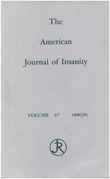Functional neuroanatomy of CCK4-induced anxiety in normal healthy volunteers
Abstract
OBJECTIVE: The authors tested the prediction of temporal cortex activation during experimentally induced anxiety by using positron emission tomography and the [15O]H2O bolus-subtraction method to determine regional cerebral blood flow (CBF) changes in normal volunteers challenged with a bolus injection of cholecystokinin tetrapeptide (CCK4). METHOD: Eight right-handed healthy subjects (five male, three female; mean age, 26.4 years) underwent four 60-second [15O]H2O scans separated by 15-minute intervals; each scan followed an intravenous bolus injection of either saline (placebo) or CCK4 (50 micrograms). Each subject received CCK4 once, as the first or second bolus, in a random-order, placebo-controlled, double-blind fashion. Two of the three placebo conditions were nominally identical, and the remaining placebo was used to control for anticipatory anxiety. Magnetic resonance imaging scans were obtained for subsequent anatomical correlation of blood flow changes. RESULTS: CCK4, but not placebo, elicited a marked anxiogenic response, reflected by robust increases in subjective anxiety ratings and heart rate. CCK4-induced anxiety was associated with 1) robust and bilateral increases in extracerebral blood flow in the vicinity of the superficial temporal artery territory and 2) CBF increases in the anterior cingulate gyrus, the claustrum-insular-amygdala region, and the cerebellar vermis. CONCLUSIONS: Some of the temporopolar cortex CBF activation peaks previously reported in humans in association with drug- and non-drug- induced anxiety, as well as the increase in regional CBF in the claustrum-insular-amygdala region, may be of vascular and/or muscular origin.
Access content
To read the fulltext, please use one of the options below to sign in or purchase access.- Personal login
- Institutional Login
- Sign in via OpenAthens
- Register for access
-
Please login/register if you wish to pair your device and check access availability.
Not a subscriber?
PsychiatryOnline subscription options offer access to the DSM-5 library, books, journals, CME, and patient resources. This all-in-one virtual library provides psychiatrists and mental health professionals with key resources for diagnosis, treatment, research, and professional development.
Need more help? PsychiatryOnline Customer Service may be reached by emailing [email protected] or by calling 800-368-5777 (in the U.S.) or 703-907-7322 (outside the U.S.).



